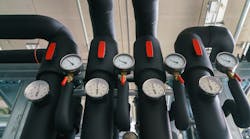Latest from Eatherton
Sponsored
This is the third and final part of a three-article series addressing the problems associated with DHW recirculation systems that cause pipe and fitting failures in the field. You can read part 1 here, and part 2 here.
This thermal close off of the flow (it doesn’t stop flow completely, it just significantly restricts flow) causes the recirculation system to become “self-balancing,” which puts the system into an “ideal” situation, whereby recirculated flows within the system are balanced out, even in parallel direct return or pyramidic parallel configurations, which results in hot water being readily available even at the furthest points of use. This flow restricting also addresses and controls the possibility of HEC (hydraulic erosion corrosion) in a properly designed system. Assuming that reasonable engineering standards were employed in the design of the hot water distribution and circulation return system, the application of these TFC devices will eliminate any future possibility of HEC occurring within the system. It can’t reverse any damage previously done, but will address future possibilities of it occurring.
When properly applied, these thermal balancing devices can be incorporated with a smart pump capable of maintain a constant pressure differential. When the system is first started, and all of the TFC devices are wide open, the recirculation return pump is moving maximum gallons per minute. Once hot water gets to the TFC device, flow is restricted. The smart pump “sees” this close off, and subsequent increase in pressure differential, and slows down to maintain the ideal pressure differential required to move fluid through the supply and return system. This will result in two guaranteed potential energy savings. One from the smart pump only using the electrical energy that is necessary to maintain minimal flows through the system, and the other by reducing the temperature of the recirculation return mains, thereby reducing thermal energy losses from the system as a whole.
In addition to the two obvious savings, an additional benefit would be the elimination of water being wasted by end users trying to get hot water to the furthest points of the distribution system. This will result in energy savings associated with the heating of the water, water treatment, electrical energy for the pumping of potable water through the system, as well as conservation of our most precious resource, that being potable water.
In Europe, the control of water borne bacteria like Legionella requires the whole distribution system to be sanitized by exposing all of the piping distribution system to extremely high operating temperatures.
After having researched all of the products on the market, I decided to choose a product built by the Caleffi company. Their model 116 “Thermosetter Balancing Valve” can be ordered with a number of combinations of devices within one product. I decided to settle on the valve with the adjustable temperature setting (95F to 140F), an integral check valve, and a thermometer. When I looked at the cost to incorporate these additional items into the application of similar devices, I found the cost rose fairly significantly in short order, as well as the overall length of the product and decided to go with the Caleffi 116.
An additional feature of this product that may come into being on newer projects is the ability of this valve to have a “thermal bypass” condition. In Europe, the control of water borne bacteria like Legionella requires the whole distribution system to be sanitized by exposing all of the piping distribution system to extremely high operating temperatures, thereby eliminating an potentially harmful bacteria from the system through scald sanitization.
In order to incorporate this thermal bypass feature into the system design, all remote points of use must have an anti-scald point of use tempering valve to disallow the possibility of the end user being exposed to the high sanitation water temperatures. This pretty much eliminates the possibility of applying the thermal bypass to older existing systems where the end users are not protected by anti-scald valves at the point of use, but it’s still a great idea that’s time is coming. American designers are slow to adopt these proven European technologies due to the constant barrage of lawyers and utility companies pushing for people to turn down their hot water heating system, not turn them up. When done correctly, the liability exposure due to hot water scalding is held to a minimum, but the benefits of not being exposed to the lethal potential of Legionella is priceless…
Tune in next month as we begin looking at boiler replacement potentials in the multi family dwelling market, and the potential energy savings associated with the application of new and not so new hydronic technologies.
Mark Eatherton material, in print and online, is protected by Copyright 2017. Any reuse of this material (print or electronic) must first have the express written permission of Mark Eatherton and CONTRACTOR magazine. Please contact via email at [email protected].
Mark Eatherton
Mark Eatherton material on this website is protected by Copyright 2017. Any reuse of this material (print or electronic) must first have the expressed written permission of Mark Eatherton and CONTRACTOR Magazine.


